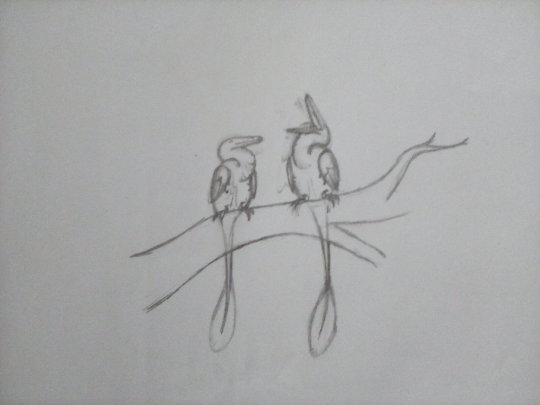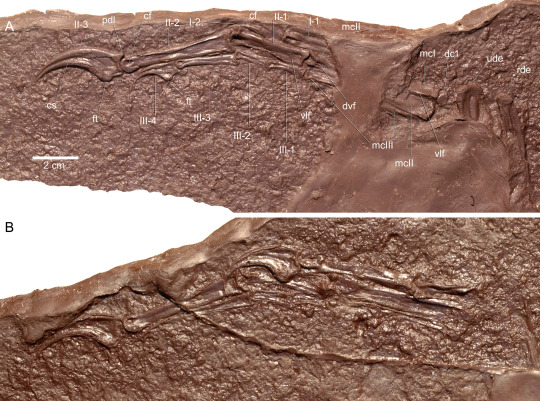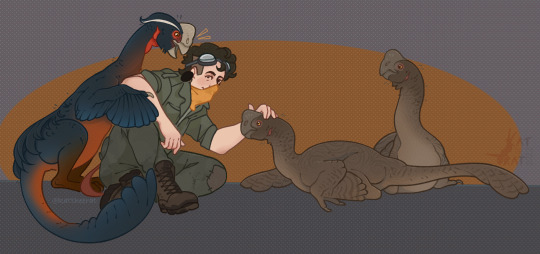#maniraptora
Text

the bush is so big, always a chance you'll meet a little feathered friend
on insta!!
598 notes
·
View notes
Text

stenonychosaurus, aka troodon
#stenonychosaurus#stenonychosaurus inequalis#troodon#troodon formosus#troodontid#troodontidae#dinosaur#dinosaurs#theropod#theropoda#theropod dinosaur#feathered dinosaur#maniraptora#paleontology#paleoart#my art
912 notes
·
View notes
Text
Dromaeosaur courtship- Dino Doodles

She's perplexed.
Inspired by the courting dance of pigeons. Not a specific species, I just wanted to have fun with the pose and familiarize with the body type, and I like the concept of bird beards, especially in bright mating colors.
A meme based on this artwork became the most popular tweet I ever made.
#dinosaurs#paleoart#digital art#artists on tumblr#my art#magnificent century level drip here#maniraptora#feathered dinosaurs#courtship#romantic#wholesome#cute#couple dynamics#relationship goals#find someone that gets silly like that#dinosaur masculinity#the future of men
467 notes
·
View notes
Text

Sleepy buitreraptors.
88 notes
·
View notes
Text

Halszkaraptorines were a group of small dromaeosaurids known only from the Late Cretaceous of Mongolia. They were odd little raptors with flattened snouts, long necks, and flipper-like arms – features that suggest they were specialized for swimming, making them the second known lineage of semi-aquatic non-avian dinosaurs after the spinosaurids.
This "duck-raptor" interpretation has been a little controversial since it was first proposed in 2017, but we've just gotten some more evidence for it in the form of an entirely new halszkaraptorine.
Natovenator polydontus lived in what is now the Gobi Desert in southern Mongolia, around 72 million years ago. The size of a small duck, about 45cm long (18"), it had jaws full of many needle-like teeth, a long flexible goose-like neck, and a streamlined body with a wide flattened ribcage convergently shaped like those of modern diving birds.
Although it had long strong legs, these don't show much in the way of aquatic specializations and would have been used more for walking and running on land. Instead it may have used its flipper-like arms to propel itself through the water, like modern penguins or auks.
It probably had a lifestyle similar to modern mergansers, swimming and diving in lakes and rivers, and preying on fish, amphibians, and aquatic invertebrates.
———
Nix Illustration | Tumblr | Twitter | Patreon
#science illustration#paleontology#paleoart#palaeoblr#natovenator#halszkaraptorinae#dromaeosaur#raptor#paraves#maniraptora#theropod#dinosaur#art#duckraptor#actual water dinosaurs
602 notes
·
View notes
Text

"Two Anchiornis Males" Krita, 2023
A little something inspired by the post I just reblogged earlier.
youtube
#krita illustration#digital art#youtube#doodle#speedpaint#digital illustration#paleoart#anchiornis#feathered dinosaurs#feathered friends#theropod#maniraptora#dromaeosaur#gay mlm#bi#lgbtq#Youtube
110 notes
·
View notes
Text

For #FossilFriday, Therizinosaurus showing off its fabulous nail job! Recently it’s been found that the claws on Therizinosaurus itself wouldn’t have worked very well as weapons OR for pulling down branches, so odds are they would have worked better for displaying, like the antlers on a deer or peacock feathers.
#fossil friday#dinosaur art#dinosaur#therizinosaurus#paleoart#paleontology#cretaceous period#mesozoic#illustration#art#procreate#artist on tumblr#maniraptora
178 notes
·
View notes
Text

Day 3: Dromaeosaurus albertensis is standing for rest.
#my art#dinosaur#paleoart#dinosaurs#myart#dinosauria#my drawings#sketchbookapp#dromaeosaurus#dromaeosaur#dromaeosaurinae#dromaeosauridae#paraves#pennaraptora#maniraptora#coelurosauria#theropoda#feathered dinosaurs#artists on tumblr#Judith River July
83 notes
·
View notes
Text

pointy lil guys
#these are really generic noncommittal dromaeosaurs tbh they're not really any one genus in particular... alas#maniraptora#dromaeosaur#velociraptor#paleoart#paleontology#dinosaur#art#sketch#orig#palaeoart#palaeoblr#original art needs the most tagwhoring smh
261 notes
·
View notes
Text
Migmanychion laiyang Wang et al., 2023 (new genus and species)

(Cast of the hand of Migmanychion laiyang, from Wang et al., 2023)
Meaning of name: Migmanychion = claw mixture [in Greek]; laiyang = Laiyang [referencing the Shandong Laiyang Cretaceous National Geological Park, where the original fossil is housed]
Age: Early Cretaceous (Aptian), about 121 million years ago
Where found: Longjiang Formation, Inner Mongolia, China
How much is known: A partial left forelimb (including a complete hand) and some rib fragments of one individual.
Notes: Migmanychion was probably a maniraptoran, a diverse group of feathered theropods including alvarezsaurs, therizinosaurs, oviraptorosaurs, and paravians (which in turn include birds). The bones in its hands were very slender and its hand claws were not sharply curved. A particularly unusual feature of its hands was that the claw of the second finger (equivalent to our index finger) was longer but not as deep as the thumb claw. In most other theropods, the longest hand claw is also the deepest.
Migmanychion might have been closely related to Fukuivenator, a maniraptoran from the Early Cretaceous of Japan that some recent studies suggest was an early therizinosaur. However, more complete specimens will likely be needed to confidently determine what type of maniraptoran Migmanychion was.
Reference: Wang, X., A. Cau, Z. Wang, K. Yu, W. Wu, Y. Wang, and Y. Liu. 2023. A new theropod dinosaur from the Lower Cretaceous Longjiang Formation of Inner Mongolia (China). Cretaceous Research advance online publication. doi: 10.1016/j.cretres.2023.105605
63 notes
·
View notes
Text

Ya'll
I just found this psd file from 2018 in one of my old folders and it has 70+ layers?? Past Me literally made a separate layer for every feather each with a matching shading layer.
How To Crash Your Drawing Program 101
I don’t even remember which bird I was referencing for these colors.
#velociraptor#dinosaur#dromaeosaur#maniraptora#paleoart#feathered dinosaurs#theropod#bird#raptor#bird of prey
22 notes
·
View notes
Text

adding omnisexual utahraptor to the bunch! <3
#utahraptor#utahraptor ostrommaysi#dromaeosaur#dromaeosaurid#dromaeosaurids#feathered dinosaur#feathered dinosaurs#dinosaur#dinosaurs#theropod#theropods#theropoda#theropod dinosaur#maniraptora#pride#lgbt#lgbtq#lgbtq pride#omnisexual#omnisexual pride#paleontology#paleoart#mesozoic#my art
190 notes
·
View notes
Text

Trying another attempt at an alvarezsaur head.
Referance
#dinosaur#dino#feathered dinosaurs#dinosaurs#paleoart#theropod#palaeoart#feathered#palaeontology#paleontology#prehistoric#paleoillustration#blender3d#3d blender#blender#cretaceous#alvarezsaur#maniraptora
163 notes
·
View notes
Text

Archaeopteryx lithographica.
Part of a bigger piece I've been working on.
50 notes
·
View notes
Text
It Came From The Wastebasket #05: The Trouble With Troodon
Troodontids were small bird-like theropod dinosaurs, lightly built with slender legs and sickle-shaped "raptor" claws on the second toes of their feet. They had fairly big brains proportional to their body size, rather like modern birds, and their large forward-facing eyes had good depth perception. Owl-like asymmetrical ears in some species gave them a very keen sense of hearing, suggesting they may have been nocturnal hunters using sound to pinpoint the location of small prey.
The original specimen of the namesake of the group, Troodon formosus, was a serrated tooth discovered in the 1850s, about 77 million years old and originating from the Late Cretaceous Judith River Formation fossil beds in Montana, USA. It was so little to work with that it was initially mistaken for a lizard tooth, then during the 20th century it was recognized as belonging to a dinosaur and spent time classified as a megalosaurid, then a pachycephalosaur, then finally as a small theropod similar to the Mongolian Saurornithoides.
In the late 1980s it was merged together with multiple other troodontids (including Stenonychosaurus of speculative "dinosauroid" fame), and since Troodon had been the first of all of them to be named it took priority as the genus name.
And then for a while every single Late Cretaceous troodontid specimen from North America was also lumped into Troodon, turning it into a wastebasket taxon.

The problem was that all these troodontids came from locations separated by thousands of kilometers and millions of years of time, and it's unlikely that they all actually represented just one single species. But they were only known from rare fragmentary remains, making distinguishing them from each other difficult, and the original Troodon tooth didn't really have any distinctive features either – it turns out most troodontid teeth all look exactly the same!
It was becmoning increasingly dubious whether Troodon was even a valid name at all, and during the 2010s several paleontologists began trying to sort the mess out. The old names Pectinodon and Stenonychosaurus were revived, and some 'Troodon' fossils were also split off and given completely new names, becoming Albertavenator and Latenivenatrix*.
* Although Latenivenatrix might not actually be distinct enough from Stenonychosaurus to justify having a separate name.
As of 2022, Troodon itself is now in a sort of taxonomic limbo, with some paleontologists abandoning it as a dubious name while others are still arguing in favor of continuing to use it. The name could potentially be properly rescued if the original tooth can be clearly linked to better fossil material, letting Troodon take over priority again from one of the other better-established troodontids, or by defining a new type species similar to what happened with Iguanodon.
…But with how incredibly generic that tooth is, both of those options would be very difficult.
———
Nix Illustration | Tumblr | Twitter | Patreon
#it came from the wastebasket#wastebasket taxon#taxonomy#troodon#stenonychosaurus#pectinodon#albertavenator#latenivenatrix#troodontid#maniraptora#theropod#dinosaur#paleontology#art#science illustration#paleoart#palaeoblr
629 notes
·
View notes
Text
My part of an art trade i had fun doing with @sycherart

#palaeoblr#paleoart#dinosaur#oviraptor#oviraptorid#dinosaurs#maniraptora#maniraptorian#oviraptorosauria#art trade#dinopocalypse#just a big rooster#my art#digital art
49 notes
·
View notes